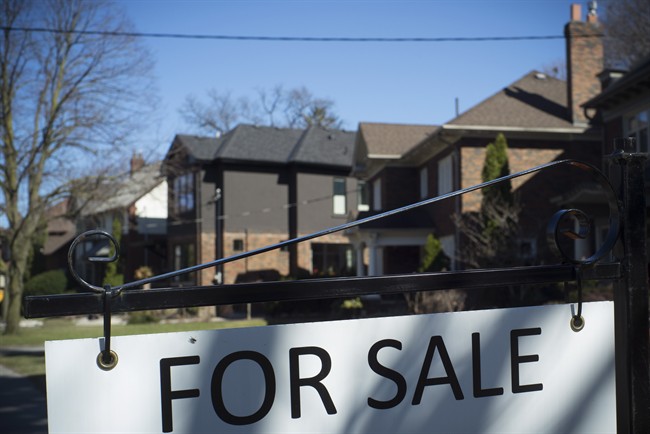The Canadian Real Estate Association says home sales in June posted their largest monthly drop since 2010, with the Greater Toronto market leading the decline.

It was the third consecutive monthly decline since March, with sales for June down 6.7 per cent compared with May on a national basis, the association said. Seventy per cent of local markets registered month-over-month declines, it added. Sales dropped by 11.4 per cent compared with June of 2016.

The biggest drop by far occurred in the Greater Toronto Area (GTA) the numbers show.
Sales of existing homes fell by over 15 per cent in Toronto, the second straight double-digit decline, with resale activity now down by a whopping 42 per cent from its March peak, TD economist Diana Petramala wrote in a brief note to clients.
READ MORE: Home prices to remain flat across Canada in 2018, says RBC – is this the new normal?
Sales were also weak in B.C., where Vancouver’s recovery from the sales slump of late last year seemed to be losing steam. Home sales were down four per cent in June, 29 per cent below their peak February 2016 levels.
Excluding Ontario and B.C., sales dipped by a modest 3.9 per cent in June compared to May, Petramala noted.
WATCH: New Toronto Real Estate Board numbers show housing sales are slumping

Toronto now officially a buyers’ market
The ratio of sales compared to new home listings fell below 40 per cent in Toronto, the statistics show.
“According to this metric, Toronto has now fully moved from sellers’ territory (ratio above 60 per cent) to buyers’ territory (ratio under 40 per cent),” Petramala wrote.
RBC economist Robert Hogue had anticipated last month that the GTA could turn into a buyers’ market. Sellers are facing some difficulties offloading properties, as buyers sit on the fence hoping for prices to come down, he noted.
READ MORE: Toronto could become a ‘buyer’s market’ in coming months: RBC
The sales-to-listings ratio is the statistical benchmark that real estate boards use to determine whether a market is in sellers’ or buyers’ territory. A ratio of around 50 per cent means around five homes are sold for every 10 that come on the market. It denotes a balanced market. A ratio above 60 per cent indicates a sellers’ market. One below 40 per cent is considered a buyers’ market.
READ MORE: What you need to know about mortgages when interest rates rise
That’s where the Toronto-area market is right now. In March, by comparison, the ratio stood at 86 per cent, meaning homes were being snatched up pretty much as soon as the “for sale” sign went up.
The dramatic U-turn in home sales happened after the Ontario government introduced a slew of housing measures in April, including a Vancouver-style tax on foreign homebuyers.
“It’s quite clear that policy changes, regardless of the number of non-resident investor transactions they’ve impacted, have worked to alter market psychology — and that is a positive outcome given the speculative dynamics in place a few months ago,” BMO economists Douglas Porter and Robert Kavcic wrote in a note on Monday.
READ MORE: Mortgage calculator: See how rising interest rates affect your payments
“The higher end of the Toronto market (call it $1.5 million plus, for argument’s sake) has gone stone cold, with prices now edging down and crickets echoing through open houses,” Kavcic noted in a different email to clients this morning.
Average home prices dropped 5.8 per cent in June compared to May on a seasonally-adjusted basis.
But prices were still up compared to June 2016. The average price tag for a home in the GTA was $793,915, 6.3 per cent above the level seen a year ago.
Home prices in Canada virtually flat compared to a year ago
On a national basis, the average price for a home sold in June was $504,458, up 0.4 per cent from a year ago. Excluding the Vancouver- and Toronto-area markets, the national average price was $394,660.
READ MORE: Home prices in Canada will keep rising, despite interest rate hike: Royal LePage
Here’s the breakdown for select Canadian cities:
The average home price in Greater Vancouver reached $1,053,655, a mind-boggling figure, but one that represents an increase of only 2.7 per cent since June of 2016. But you can still find double-digit price increases in B.C. The price of a home in Victoria, in fact, reached $674,952, up nearly 15 per cent from a year ago.
Buying a home in Calgary now costs $483,106, up 3.5 per cent since the same period last year.
In Regina, the average home costs $294,991, down a whopping 11 per cent from June of 2016. Prices were virtually flat in Saskatoon.
In Winnipeg, prices crossed the $300,000 mark, at $302,900 or 2.8 per cent above year-ago levels.
Ottawa bucked the trend seen in Ontario’s hottest markets, with the average home price rising by 7.5 per cent to $410,032.
Montreal also posted healthy gains: up 5.6 per cent to $373,780.
In Saint John, the average cost of a home was $188,119, up 4.7 per cent since June of 2016.
In the Halifax-Dartmouth region, prices slipped 0.8 per cent, to $290,008.
– With files from the Canadian Press




Comments